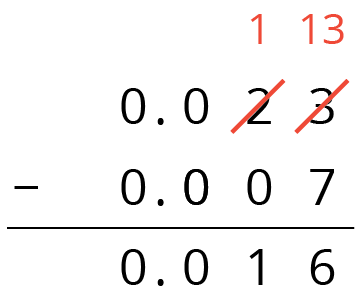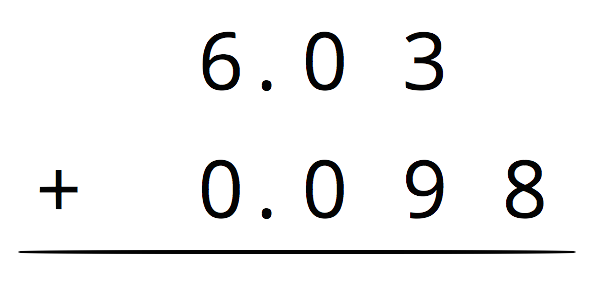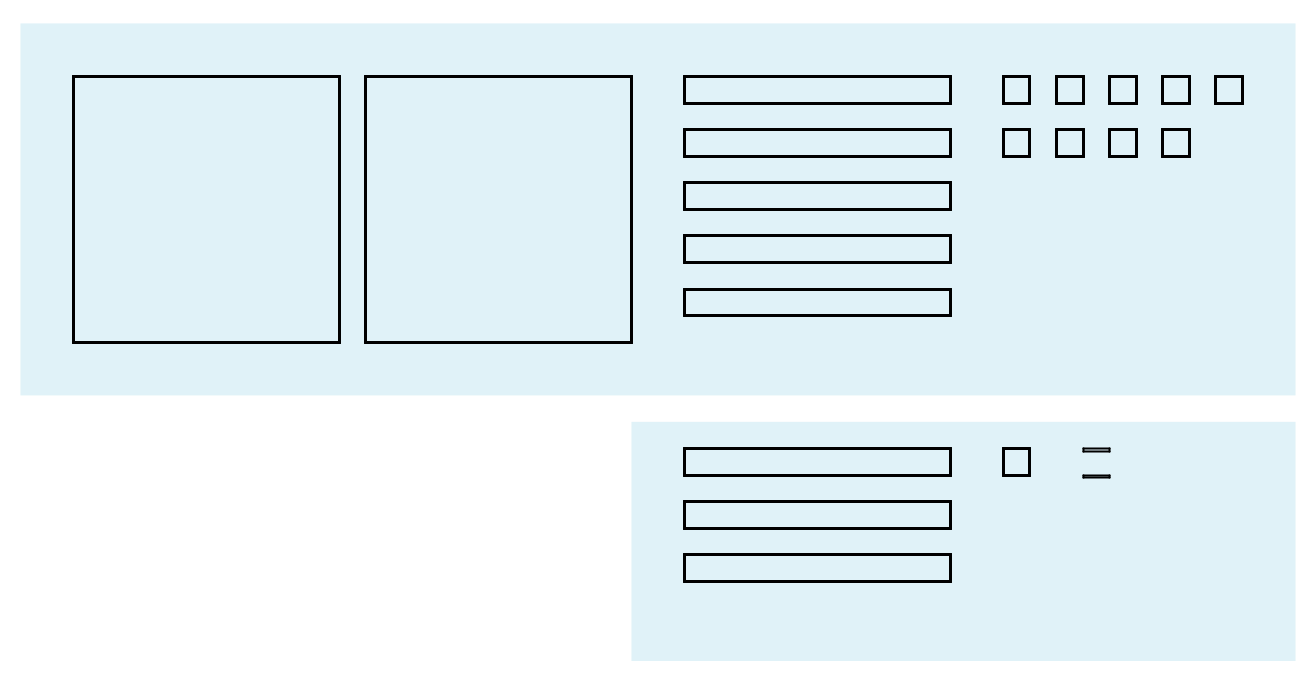Lesson 14
Using Diagrams to Represent Addition and Subtraction
14.1: Do the Zeros Matter? (5 minutes)
Warm-up
This warm-up prompts students to reason about regrouping and about when the zeros in a decimal affect the number that it represents. The mathematical work of interest is how students combine two decimals (e.g., in analyzing \(1.009 + 0.391\), do they see that \(0.009 + 0.001 = 0.010\)?) and how they write the sum (e.g., do they know \(1.4=1.40=1.400\)?).
Launch
Arrange students in groups of 2. Give students 1 minute of quiet time to mentally add the decimals in the first problem and then another minute to discuss their answer and strategy with a partner. Briefly discuss their strategies as a class, and then ask students to complete the true-or-false questions.
Student Facing
-
Evaluate mentally: \(1.009+0.391\)
-
Decide if each equation is true or false. Be prepared to explain your reasoning.
- \(34.56000 = 34.56\)
- \(25 = 25.0\)
- \(2.405 = 2.45\)
Student Response
For access, consult one of our IM Certified Partners.
Anticipated Misconceptions
Some students may say, “You can take the zeros away after the decimal point and the number stays the same.” Although students could mean, for instance, that 12.9 is equal to 12.90, they might also mistakenly think 12.09 is equal 12.9. Ask these students to be more precise in their statement. Ask if the zero can be in any place after the decimal point or only in certain places.
Activity Synthesis
Ask students to indicate whether they think each equation is true or false and ask for an explanation for each. Students may simply say that we can or cannot just remove the zeros. Encourage them to use what they know about place values or comparison strategies to explain why one number is greater than, less than, or equal to the other. If students do not notice that the two numbers in the true-or-false questions have the same digits except for the missing zeros, point that out after each question.
If not mentioned by students in their explanations, ask:
- “Can zeros be written at the end of a decimal without changing the number that it represents?”
- “Can zeros be eliminated from the end of a decimal without changing the value?”
- “Can zeros be written or erased in the middle of a decimal without changing the value?”
14.2: Finding Sums in Different Ways (15 minutes)
Optional activity
In this activity, students use symbols and diagrams to find a sum that requires regrouping of base-ten units. Use this activity to give students more explicit instruction on how to bundle smaller units into a larger one and additional practice on using addition algorithm to add decimals.
Again, consider having physical base-ten blocks, a paper version of the base-ten figures, or this digital applet ggbm.at/n9yaWPQj available as alternatives to diagram drawing, or to more concretely illustrate the idea of bundling and unbundling.
Launch
Arrange students in groups of 2. Give groups 4–5 minutes to discuss and answer the first question, and then 7–8 minutes of quiet time to complete the remaining questions. Provide access to base-ten representations, if needed.

Supports accessibility for: Organization; Attention
Student Facing
-
Here are two ways to calculate the value of \(0.26 + 0.07\). In the diagram, each rectangle represents 0.1 and each square represents 0.01.
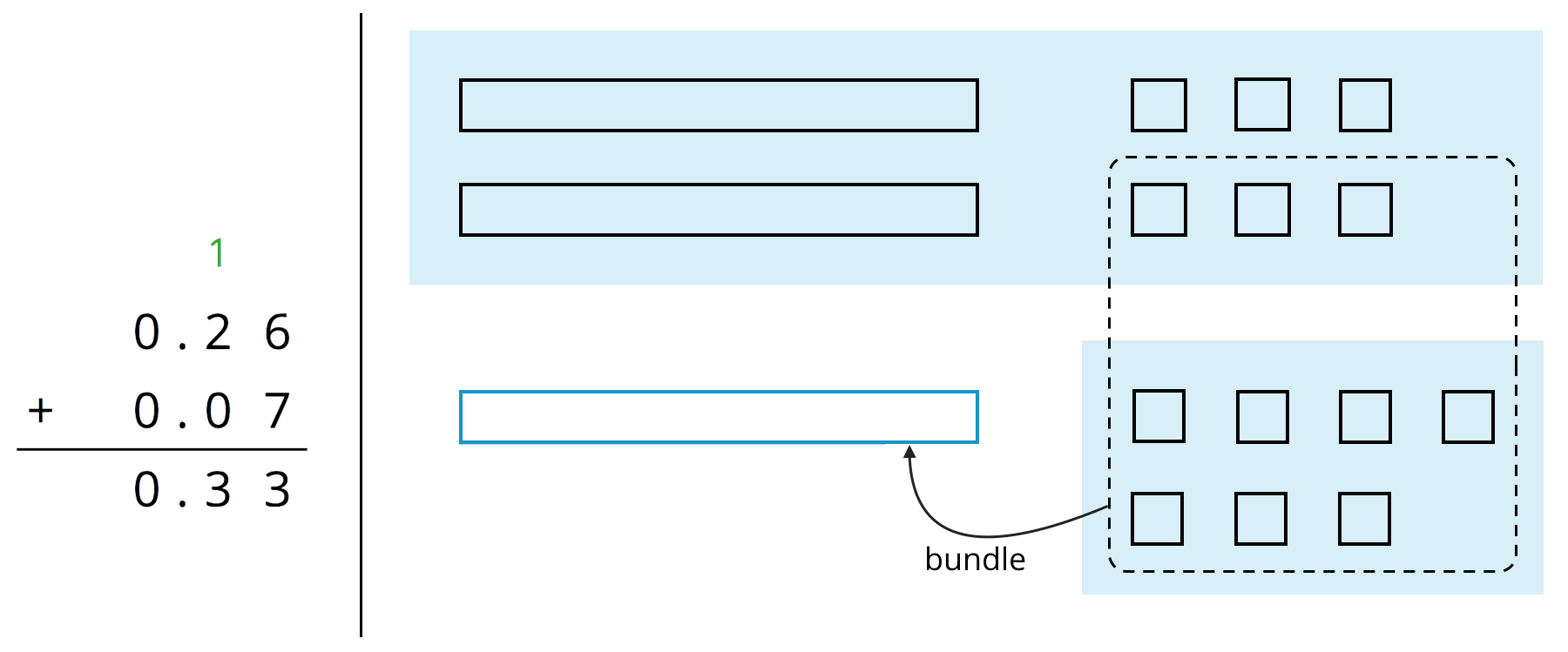
Use what you know about base-ten units and addition of base-ten numbers to explain:
-
Why ten squares can be “bundled” into a rectangle.
-
How this “bundling” is reflected in the computation.
The applet has tools that create each of the base-ten blocks. Select a Block tool, and then click on the screen to place it.

One

Tenth

Hundredth
Click on the Move tool when you are done choosing blocks.

-
-
Find the value of \(0.38 + 0.69\) by drawing a diagram. Can you find the sum without bundling? Would it be useful to bundle some pieces? Explain your reasoning.
-
Calculate \(0.38 + 0.69\). Check your calculation against your diagram in the previous question.
-
Find each sum. The larger square represents 1, the rectangle represents 0.1, and the smaller square represents 0.01.
-
Student Response
For access, consult one of our IM Certified Partners.
Launch
Arrange students in groups of 2. Give groups 4–5 minutes to discuss and answer the first question, and then 7–8 minutes of quiet time to complete the remaining questions. Provide access to base-ten representations, if needed.

Supports accessibility for: Organization; Attention
Student Facing
- Here are two ways to calculate the value of \(0.26 + 0.07\). In the diagram, each rectangle represents 0.1 and each square represents 0.01.

Use what you know about base-ten units and addition to explain:
- Why ten squares can be “bundled” into a rectangle.
- How this “bundling” is represented in the vertical calculation.
- Find the value of \(0.38 + 0.69\) by drawing a diagram. Can you find the sum without bundling? Would it be useful to bundle some pieces? Explain your reasoning.
- Calculate \(0.38 + 0.69\). Check your calculation against your diagram in the previous question.
-
Find each sum. The larger square represents 1.
-
Student Response
For access, consult one of our IM Certified Partners.
Student Facing
Are you ready for more?
A distant, magical land uses jewels for their bartering system. The jewels are valued and ranked in order of their rarity. Each jewel is worth 3 times the jewel immediately below it in the ranking. The ranking is red, orange, yellow, green, blue, indigo, and violet. So a red jewel is worth 3 orange jewels, a green jewel is worth 3 blue jewels, and so on.
-
If you had 500 violet jewels and wanted to trade so that you carried as few jewels as possible, which jewels would you have?
-
Suppose you have 1 orange jewel, 2 yellow jewels, and 1 indigo jewel. If you’re given 2 green jewels and 1 yellow jewels, what is the fewest number of jewels that could represent the value of the jewels you have?
Student Response
For access, consult one of our IM Certified Partners.
Anticipated Misconceptions
If students have difficulty drawing the diagrams to represent bundling, it might be helpful for them to work with actual base-ten blocks, paper printouts of base-ten blocks, or digital base-ten blocks so that they can physically trade 10 hundredths for 1 tenth or 10 tenths for 1 whole.
Activity Synthesis
Focus the whole-class debriefing on the idea of choosing appropriate tools to solve a problem, which is an important part of doing mathematics (MP5). Highlight how drawings can effectively help us understand what is happening when we add base-ten numbers before moving on to a more generalized method. Discuss:
- “In which place(s) did bundling happen when adding 0.38 and 0.69?” (In the hundredth and tenth places.) “Why?” (There is a total of 17 hundredths, and 10 hundredths can be bundled to make 1 tenth. This 1 tenth is added to the 3 tenths and 6 tenths, which makes 10 tenths. Ten tenths can be bundled into 1 one.)
- “How can the bundling process be represented in vertical calculations?” (We can show that the 8 hundredths and 9 hundredths make 1 tenth and 7 hundredths by recording 7 hundredths and writing a 1 above the 3 tenths in 0.38.)
- “Which method of calculating is more efficient?” (It depends on the complexity and size of the numbers. The drawings become hard when there are lots of digits or when the digits are large. The algorithm works well in all cases, but it is more abstract and requires that all bundling be recorded in the right places.)
Design Principle(s): Support sense-making; Maximize meta-awareness
14.3: Subtracting Decimals of Different Lengths (25 minutes)
Activity
In this activity, students encounter two variations of decimal subtraction in which regrouping is involved. They subtract a number with more decimal places from one with fewer decimal places (e.g., \(0.1 - 0.035\)), and subtract two digits that represent the same place value but where the value in the second number is greater than that in the starting number (e.g., in \(1.12 - 0.47\), both the tenth and hundredth values in the second number is larger than those in the first).
Students represent these situations with base-ten diagrams and study how to perform them using vertical calculations. The big idea here is that of “unbundling” or of decomposing a unit with 10 of another unit that is \(\frac{1}{10}\) its size to make it easier to subtract. In some cases, students would need to decompose twice before subtracting (e.g., a tenth into 10 hundredths, and then 1 hundredth into 10 thousandths).
Use the whole-class discussion to highlight the correspondences between the two methods and to illustrate how writing zeros at the end of a decimal helps us perform subtraction.
As in previous activities, consider having students use physical base-ten blocks (if available), a paper version of the base-ten figures (from the blackline master), or this digital applet https://ggbm.at/FXEZD466, as alternatives to drawing diagrams.
Launch
Keep students in the same groups of 2. Give partners 4–5 minutes to complete the first two questions. Then, give students 4–5 minutes of quiet time to complete the last question and follow with a whole-class discussion.


Use MLR2 (Collect and Display) to listen for and capture two or three different ways students refer to the idea of “unbundling” as they work on problems 1 and 2.
Supports accessibility for: Conceptual processing
Student Facing
To represent \(0.4 - 0.03\), Diego and Noah drew different diagrams. Each rectangle represented 0.1. Each square represented 0.01.
-
Diego started by drawing 4 rectangles to represent 0.4. He then replaced 1 rectangle with 10 squares and crossed out 3 squares to represent subtraction of 0.03, leaving 3 rectangles and 7 squares in his diagram.
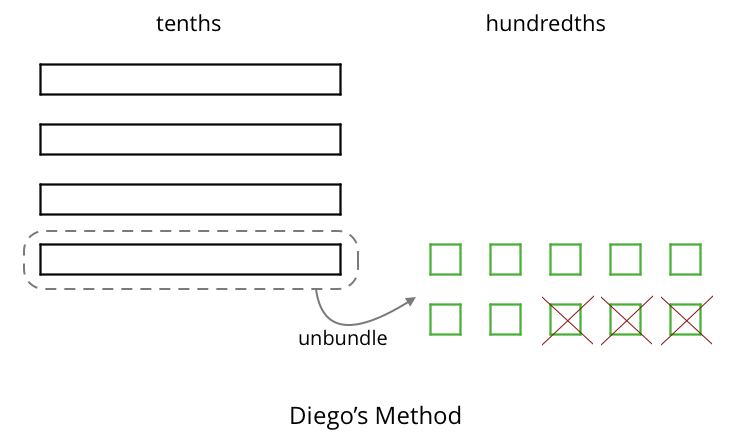
-
Noah started by drawing 4 rectangles to represent 0.4. He then crossed out 3 of rectangles to represent the subtraction, leaving 1 rectangle in his diagram.
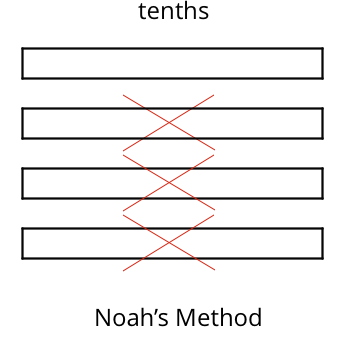
-
Do you agree that either diagram correctly represents \(0.4 - 0.03\)? Discuss your reasoning with a partner.
-
To represent \(0.4 - 0.03\), Elena drew another diagram. She also started by drawing 4 rectangles. She then replaced all 4 rectangles with 40 squares and crossed out 3 squares to represent subtraction of 0.03, leaving 37 squares in her diagram. Is her diagram correct? Discuss your reasoning with a partner.
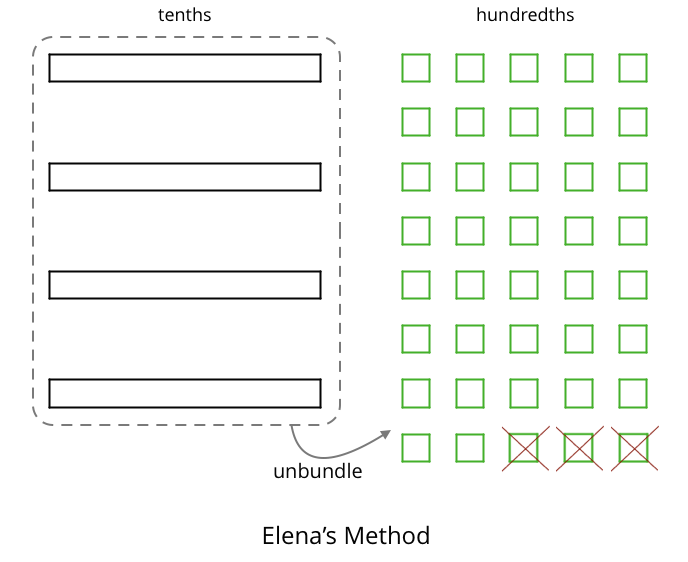
- Find each difference. If you get stuck, you can use the applet to represent each expression and find its value.
- \(0.3 - 0.05\)
- \(2.1 - 0.4\)
- \(1.03 - 0.06\)
- \(0.02 - 0.007\)
Be prepared to explain your reasoning.
- The applet has tools that create each of the base-ten blocks. This time you need to decide the value of each block before you begin.
- Select a Block tool, and then click on the screen to place it.
- Click on the Move tool (the arrow) when you are done choosing blocks.
- Subtract by deleting with the delete tool (the trash can), not by crossing out.
Student Response
For access, consult one of our IM Certified Partners.
Launch
Keep students in the same groups of 2. Give partners 4–5 minutes to complete the first two questions. Then, give students 4–5 minutes of quiet time to complete the last question and follow with a whole-class discussion.


Use MLR2 (Collect and Display) to listen for and capture two or three different ways students refer to the idea of “unbundling” as they work on problems 1 and 2.
Supports accessibility for: Conceptual processing
Student Facing
Diego and Noah drew different diagrams to represent \(0.4 - 0.03\). Each rectangle represents 0.1. Each square represents 0.01.
- Diego started by drawing 4 rectangles to represent 0.4. He then replaced 1 rectangle with 10 squares and crossed out 3 squares to represent subtraction of 0.03, leaving 3 rectangles and 7 squares in his diagram.

- Noah started by drawing 4 rectangles to represent 0.4. He then crossed out 3 rectangles to represent the subtraction, leaving 1 rectangle in his diagram.

-
Do you agree that either diagram correctly represents \(0.4 - 0.03\)? Discuss your reasoning with a partner.
- Elena also drew a diagram to represent \(0.4 - 0.03\). She started by drawing 4 rectangles. She then replaced all 4 rectangles with 40 squares and crossed out 3 squares to represent subtraction of 0.03, leaving 37 squares in her diagram. Is her diagram correct? Discuss your reasoning with a partner.

-
Find each difference. Explain or show your reasoning.
-
\(0.3 - 0.05\)
-
\(2.1 - 0.4\)
-
\(1.03 - 0.06\)
-
\(0.02 - 0.007\)
-
Student Response
For access, consult one of our IM Certified Partners.
Student Facing
Are you ready for more?
A distant, magical land uses jewels for their bartering system. The jewels are valued and ranked in order of their rarity. Each jewel is worth 3 times the jewel immediately below it in the ranking. The ranking is red, orange, yellow, green, blue, indigo, and violet. So a red jewel is worth 3 orange jewels, a green jewel is worth 3 blue jewels, and so on.
At the Auld Shoppe, a shopper buys items that are worth 2 yellow jewels, 2 green jewels, 2 blue jewels, and 1 indigo jewel. If they came into the store with 1 red jewel, 1 yellow jewel, 2 green jewels, 1 blue jewel, and 2 violet jewels, what jewels do they leave with? Assume the shopkeeper gives them their change using as few jewels as possible.
Student Response
For access, consult one of our IM Certified Partners.
Anticipated Misconceptions
If students struggle to subtract two numbers that do not have the same number of decimal digits (such as in questions 3a and 3d), consider representing the subtraction with base-ten diagrams. For example, to illustrate \(0.3 - 0.05\), start by drawing 3 large rectangles to represent 3 tenths. Replace 1 rectangle with 10 squares, each representing 1 hundredth. Cross out 5 squares to show subtraction of 5 hundredths. Alternatively, replace 3 rectangles (3 tenths) with 30 squares (30 hundredths), cross out 5 squares to show subtraction of 5 hundredths.
Activity Synthesis
The purpose of this discussion is for students to make connections between two different and correct ways to subtract decimals when unbundling is required. Ask:
- “What is the difference between Diego’s method and Elena’s method?” (Diego only breaks up 1 tenth into 10 hundredths, whereas Elena breaks up all 4 tenths into hundredths.)
- “What are some advantages to Diego’s method?” (Diego’s method is quicker to draw. It shows the 3 tenths and 7 hundredths. Elena would need to count how many hundredths she has.)
- “What are some advantages to Elena’s method?” (Elena’s diagram shows a difference of 37 hundredths, which matches how we say 0.37 in words.)
Consider connecting the diagrams for Diego’s and Elena’s work with numerical equations as shown here.
| Diego’s | Elena’s |
|---|---|
|
0.4 - 0.03 |
0.4 - 0.03 = 0.40 - 0.03 = 0.37 |
We can also show both calculations by arranging the numbers vertically. On the left, the 3 and 10 in red show Diego’s unbundling of the 4 hundredths. The calculation on the right illustrates Elena’s representation: the 0 written in blue helps us see 4 tenths as 40 hundredths, from which we can subtract 3 hundredths to get 37 hundredths. Use this example to reinforce that writing an additional zero at the end of a non-zero decimal does not change its value.
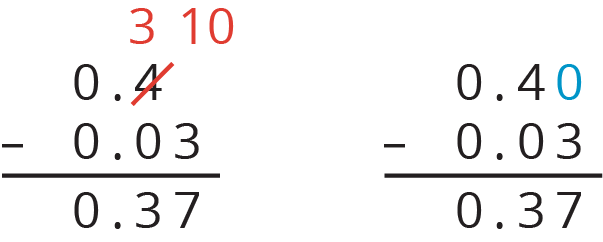
To deepen students’ understanding, consider asking:
- “In the problem \(2.1 - 0.4\), how does unbundling in the diagram show up in the vertical calculation with numbers?” (In the diagram, we unbundle 1 whole to make 10 tenths. With the calculation, we rewrite 1 whole as 10 tenths (over the tenth place) and combine it to the given 1 tenth before subtracting 4 tenths.)
- “When might it be really cumbersome to subtract using base-ten diagrams? Can you give examples?” (When the numbers involve many decimal places, such as \(113.004 - 6.056802\), or a problem with large digits, such as \(7.758 - 0.869\).)
Emphasize that the algorithm (vertical calculation) for subtraction of decimals works like the algorithm for subtraction of whole numbers. The only difference is that the values involved in the subtraction problems can now include tenths, hundredths, thousandths, and so on. The key in both cases is to pay close attention to the place values of the digits in the two numbers.
Lesson Synthesis
Lesson Synthesis
One main idea in this lesson is that addition of decimals beyond hundredths works the same way as addition of whole numbers and decimals up to hundredths. We saw that decimal addition and subtraction problems can be done with base-ten diagrams or with vertical calculations. In both cases, it is important to add or subtract the values that are in the same decimal place. Another main idea is bundling: we can group 10 of any base-ten unit into 1 of a base-ten unit that is 10 times as large.
- How do the pieces representing ones, tenths, hundredths, etc. of a base-ten diagram help us add two decimals? (We can combine the pieces that represent the same unit and see the value for each decimal place.)
- When might we want to bundle some of the base-ten pieces? (When we have at least 10 of the same unit.) Why? (It would make it simpler to show or tell the sum.)
- How is adding or subtracting with vertical calculations similar to and different from using base-ten diagrams? (We still combine numbers based on their place values but without drawing figures to represent each number.)
- When using vertical calculations, how do we make sure that we add or subtract like base-ten units? (We line up digits that represent the same place value or line up the decimal point.)
- Which method of calculating is more efficient? (It depends on the size of the numbers, but vertical calculations tend to be quicker. Drawing becomes hard when the numbers have lots of digits, e.g., 2.315641, or when the digits are large, e.g., 9.999.)
14.4: Cool-down - Why or Why Not? (5 minutes)
Cool-Down
For access, consult one of our IM Certified Partners.
Student Lesson Summary
Student Facing
Base-ten diagrams represent collections of base-ten units—tens, ones, tenths, hundredths, etc. We can use them to help us understand sums of decimals.
Suppose we are finding \(0.08 + 0.13\). Here is a diagram where a square represents 0.01 and a rectangle (made up of ten squares) represents 0.1.
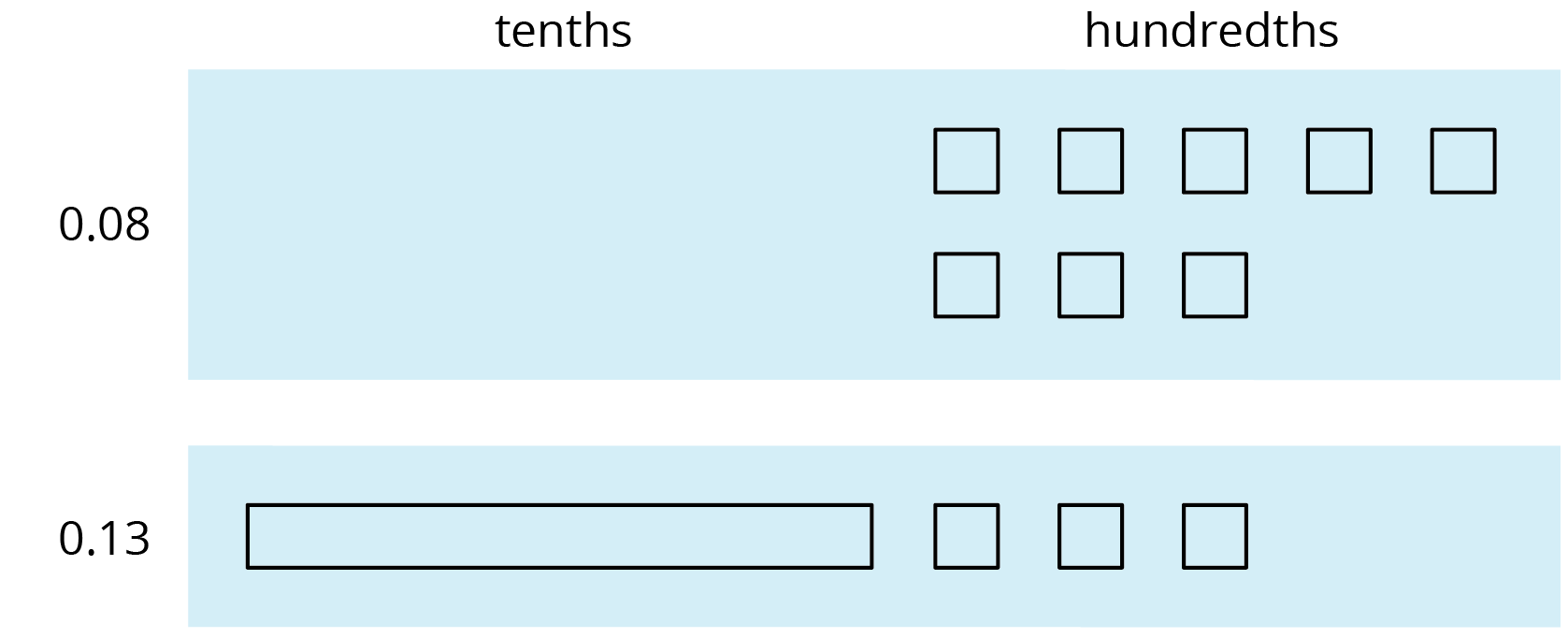
To find the sum, we can “bundle” (or compose) 10 hundredths as 1 tenth.
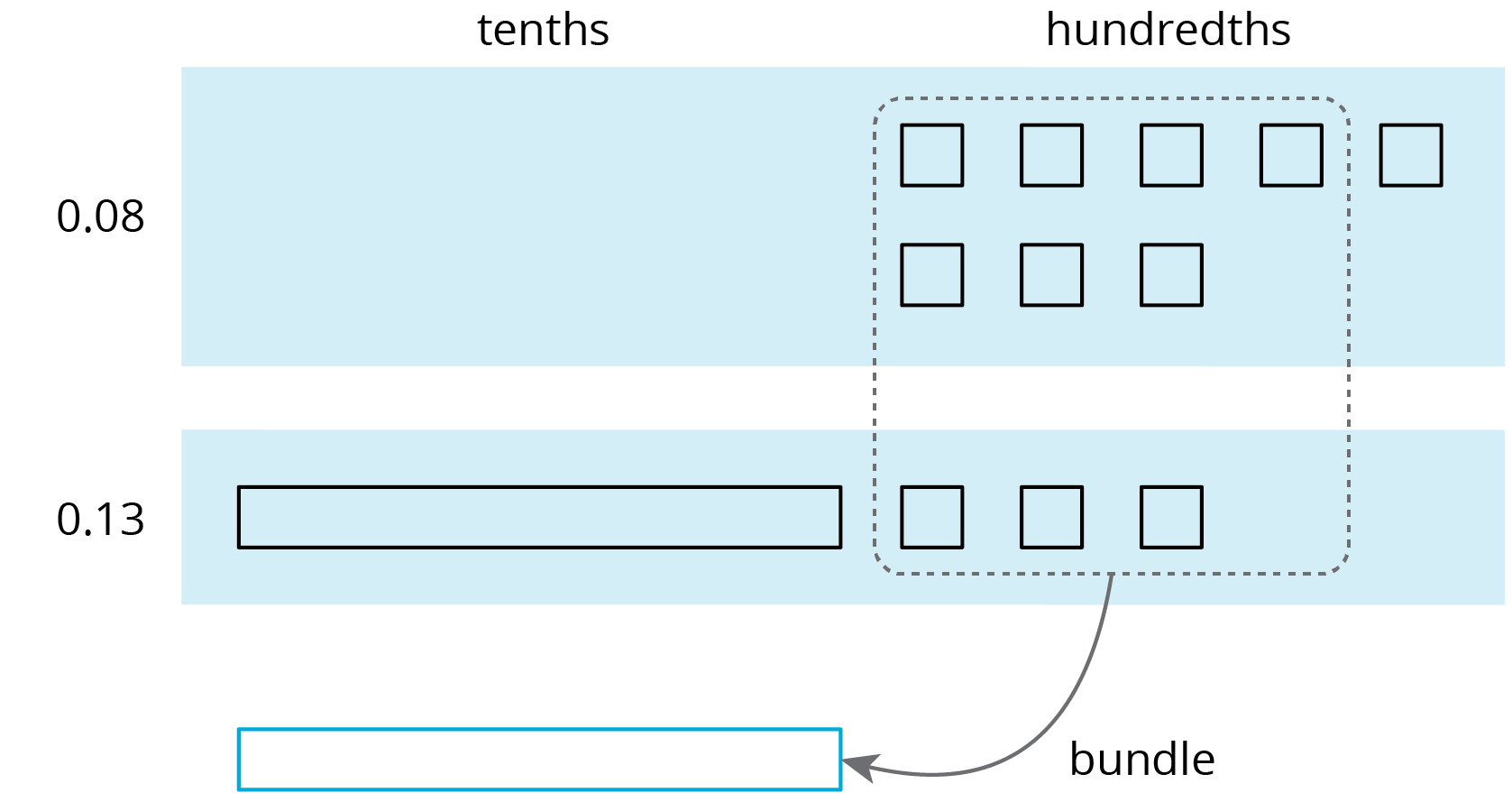
We now have 2 tenths and 1 hundredth, so \(0.08 + 0.13 = 0.21\).

We can also use vertical calculation to find \(0.08 + 0.13\).
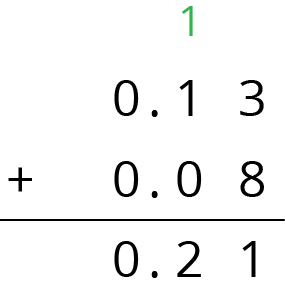
Notice how this representation also shows 10 hundredths are bundled (or composed) as 1 tenth.
This works for any decimal place. Suppose we are finding \(0.008 + 0.013\). Here is a diagram where a small rectangle represents 0.001.
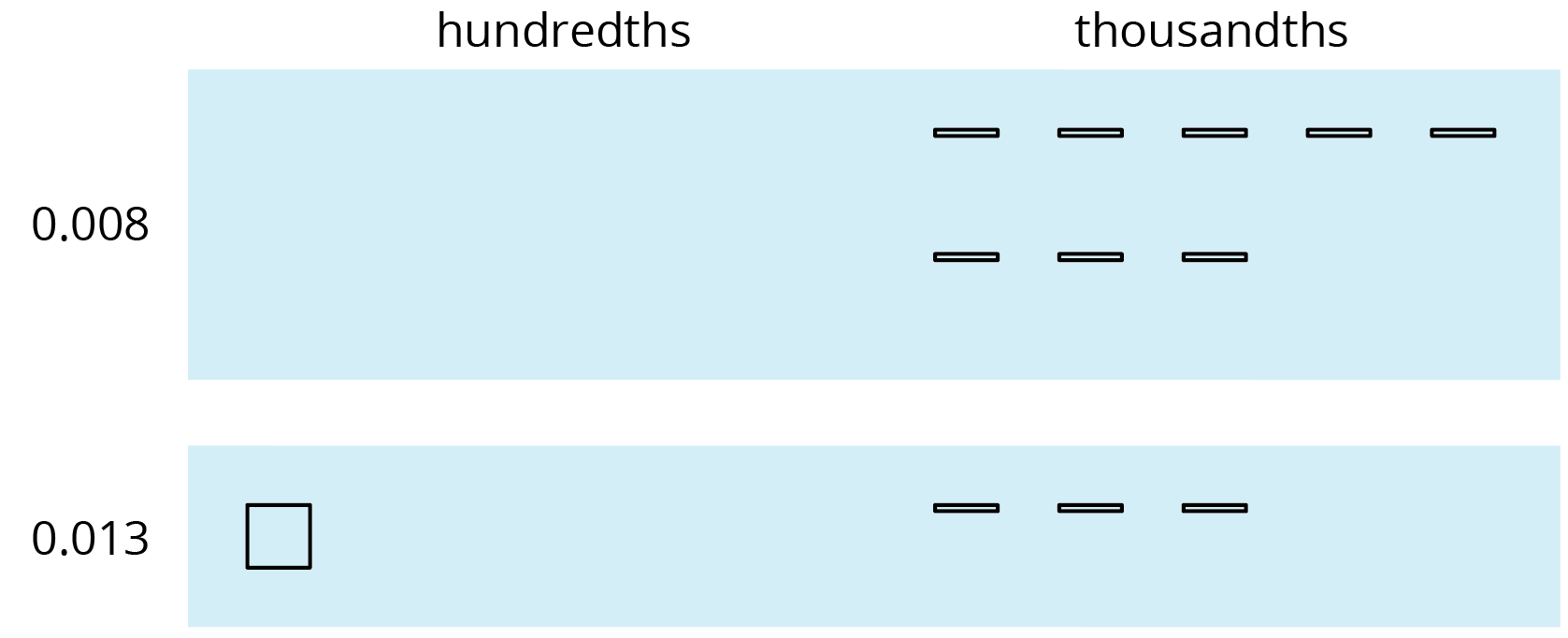
We can “bundle” (or compose) 10 thousandths as 1 hundredth.
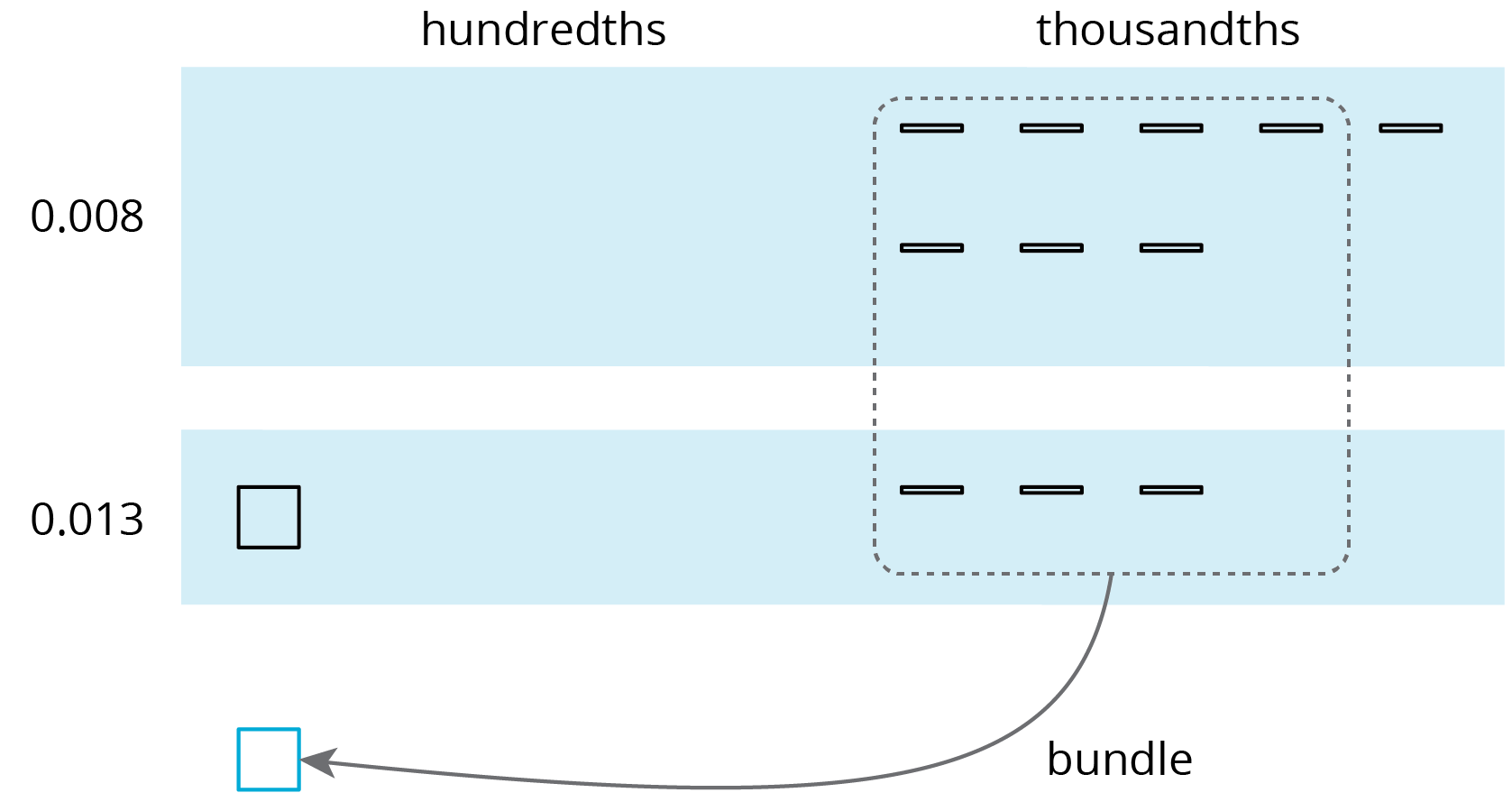
The sum is 2 hundredths and 1 thousandth.

Here is a vertical calculation of \(0.008 + 0.013\).
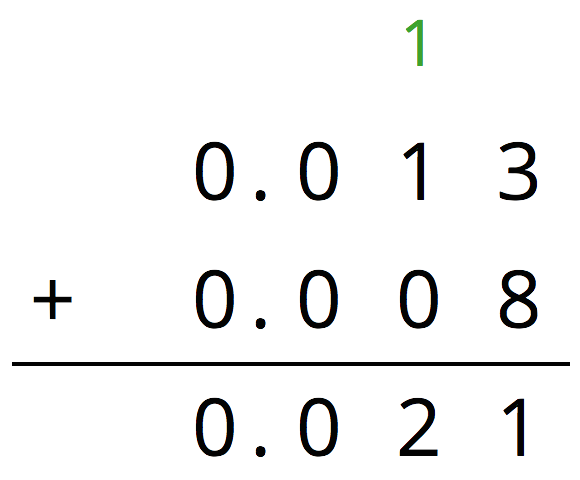
Base-ten diagrams can help us understand subtraction as well. Suppose we are finding \(0.23 - 0.07\). Here is a diagram showing 0.23, or 2 tenths and 3 hundredths.

Subtracting 7 hundredths means removing 7 small squares, but we do not have enough to remove. Because 1 tenth is equal to 10 hundredths, we can “unbundle” (or decompose) one of the tenths (1 rectangle) into 10 hundredths (10 small squares).

We now have 1 tenth and 13 hundredths, from which we can remove 7 hundredths.

We have 1 tenth and 6 hundredths remaining, so \(0.23 - 0.07 = 0.16\).

Here is a vertical calculation of \(0.23 - 0.07\).
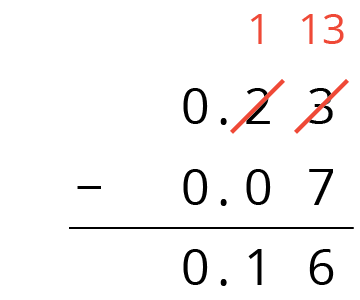
Notice how this representation also shows a tenth is unbundled (or decomposed) into 10 hundredths in order to subtract 7 hundredths.
This works for any decimal place. Suppose we are finding \(0.023 - 0.007\). Here is a diagram showing 0.023.

We want to remove 7 thousandths (7 small rectangles). We can “unbundle” (or decompose) one of the hundredths into 10 thousandths.

Now we can remove 7 thousandths.

We have 1 hundredth and 6 thousandths remaining, so \(0.023 - 0.007 = 0.016\).

Here is a vertical calculation of \(0.023 - 0.007\).
